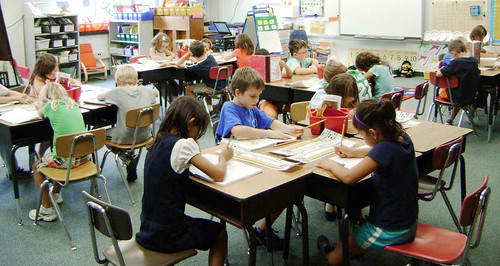
It’s that time of year! Back to school season is upon us and agencies across the U.S. Department of Agriculture (USDA) are working to ensure a stronger and healthier future for our nation’s next generation of leaders. That means providing a happy and healthy learning environment for our kids, and helping them grow up with the tools they need to succeed.
Here we’ve assembled a few youth-focused curriculum and learning resources from USDA to help teachers, administrators and parents give kids fun tools for the classroom and beyond. This is just a teaser, and there’s more where that came from. Be sure to check out our USDA for Kids page as well for more resources for the classroom.
Nutrition and Health
The Food and Nutrition Service (FNS) recently released three free sets of curriculum educators can use to empower children to make healthful food choices and develop an awareness of how fruits and vegetables are grown. The first curriculum is the The Great Garden Detective Adventure for 3rd and 4th graders that helps students discover what fruits and vegetables are sweetest, crunchiest, and juiciest through investigations and fun experiences connecting the school garden to the classroom, school cafeteria and home. The second is Dig In!, a supplemental unit for 5th and 6th graders aimed at encouraging fruit and vegetable choices. For younger children, FNS’ updated Grow It! Try It! Like It!: Preschool Fun with Fruits and Vegetables which links activities at child care centers with resources for use at home. Though the included lessons, children are taught to touch, smell, and taste new fruits and vegetables. The curriculum also integrates planting activities to help little ones connect the delicious food choices at the table with the different growing conditions and plants that produce fruits and vegetables. Get more information in this post on the USDA blog.
School Gardening
Let’s Move and USDA’s People’s Garden Initiative developed this School Garden Checklist just for you! We hope it’s helpful in your efforts to begin a school garden program. Did you know? 164 schools across the country are growing People’s Garden. You can join the movement and register a new or existing school garden as a People’s Garden on the People’s Garden website. Find a “How To” blog on how to create a school garden here.
Ag Stats and Math
Increasing statistical literacy in youth is an important way to develop the next generation of statisticians. The National Agricultural Statistics Service and the American Statistical Association (ASA) with guidance from the National Agriculture in the Classroom organization developed a Food Preference Survey lesson, activities, and extensions that build on the existing ASA Census at School survey with an agricultural tie-in. The lesson teaches and addresses common core standards for grades 5-8 in Mathematics, Language Arts, Nutrition, Social Studies, National Family and Consumer Sciences. Students complete a brief online survey, analyze their class census results, and compare their class with random samples from students in the United States and other countries. Start here on the NASS website.
Plant and Animal Health
USDA's Animal and Plant Health Inspection Service (APHIS) is offering a curriculum educators can use to empower kids to help save America's Trees. The invasive Asian longhorned beetle (ALB) has infested trees in New York, New Jersey, Illinois, Massachusetts and Ohio, and all states are at risk. The "Educator's Guide To Stopping the Asian Longhorned Beetle" is a fun, inquiry-based program to empower upper elementary, middle school, and high school students to play a central role in saving their community's trees while learning important science concepts. Through flexible, standards-based units - educators will easily meet curricular needs while challenging students to apply their knowledge and make a difference in their community. Educators can choose grade-appropriate units, such as Smart Searchers, where students become Beetle Busters, helping to protect their trees by searching for and reporting the beetle. Or, Community Leaders, where students become community leaders as they meet content standards while building scientific-inquiry, leadership, and civic engagement skills. Additional components include a Parent Flyer (available in English and Spanish), Family Activity Pack, Year-Round Calendar, Classroom Poster (available in both English and Spanish) and Bookmarks. Program tools include supplemental resources, Scouting and 4H badges and activities. See more on the APHIS website.



